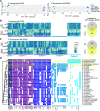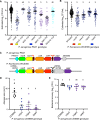The ColR/S two-component system is a conserved determinant of host association across Pseudomonas species
- PMID: 36424517
- PMCID: PMC9859794
- DOI: 10.1038/s41396-022-01343-3
The ColR/S two-component system is a conserved determinant of host association across Pseudomonas species
Abstract
Members of the bacterial genus Pseudomonas form mutualistic, commensal, and pathogenic associations with diverse hosts. The prevalence of host association across the genus suggests that symbiosis may be a conserved ancestral trait and that distinct symbiotic lifestyles may be more recently evolved. Here we show that the ColR/S two-component system, part of the Pseudomonas core genome, is functionally conserved between Pseudomonas aeruginosa and Pseudomonas fluorescens. Using plant rhizosphere colonization and virulence in a murine abscess model, we show that colR is required for commensalism with plants and virulence in animals. Comparative transcriptomics revealed that the ColR regulon has diverged between P. aeruginosa and P. fluorescens and deleting components of the ColR regulon revealed strain-specific, but not host-specific, requirements for ColR-dependent genes. Collectively, our results suggest that ColR/S allows Pseudomonas to sense and respond to a host, but that the ColR-regulon has diverged between Pseudomonas strains with distinct lifestyles. This suggests that conservation of two-component systems, coupled with life-style dependent diversification of the regulon, may play a role in host association and lifestyle transitions.
© 2022. The Author(s), under exclusive licence to International Society for Microbial Ecology.
Conflict of interest statement
The authors declare no competing interests.
Figures




Similar articles
-
Origins of symbiosis: shared mechanisms underlying microbial pathogenesis, commensalism and mutualism of plants and animals.FEMS Microbiol Rev. 2023 Nov 1;47(6):fuac048. doi: 10.1093/femsre/fuac048. FEMS Microbiol Rev. 2023. PMID: 36521845 Free PMC article. Review.
-
Commensal Pseudomonas fluorescens Strains Protect Arabidopsis from Closely Related Pseudomonas Pathogens in a Colonization-Dependent Manner.mBio. 2021 Feb 22;13(1):e0289221. doi: 10.1128/mbio.02892-21. Epub 2022 Feb 1. mBio. 2021. PMID: 35100865 Free PMC article.
-
Convergent gain and loss of genomic islands drive lifestyle changes in plant-associated Pseudomonas.ISME J. 2019 Jun;13(6):1575-1588. doi: 10.1038/s41396-019-0372-5. Epub 2019 Feb 20. ISME J. 2019. PMID: 30787396 Free PMC article.
-
Identification of ColR binding consensus and prediction of regulon of ColRS two-component system.BMC Mol Biol. 2009 May 16;10:46. doi: 10.1186/1471-2199-10-46. BMC Mol Biol. 2009. PMID: 19445690 Free PMC article.
-
Protein secretion systems of Pseudomonas aeruginosa and P fluorescens.Biochim Biophys Acta. 2003 Apr 1;1611(1-2):223-33. doi: 10.1016/s0005-2736(03)00059-2. Biochim Biophys Acta. 2003. PMID: 12659964 Review.
Cited by
-
Mechanisms underlying the low-temperature adaptation of 17β-estradiol-degrading bacterial strain Rhodococcus sp. RCBS9: insights from physiological and transcriptomic analyses.Front Microbiol. 2024 Nov 21;15:1465627. doi: 10.3389/fmicb.2024.1465627. eCollection 2024. Front Microbiol. 2024. PMID: 39640852 Free PMC article.
-
Origins of symbiosis: shared mechanisms underlying microbial pathogenesis, commensalism and mutualism of plants and animals.FEMS Microbiol Rev. 2023 Nov 1;47(6):fuac048. doi: 10.1093/femsre/fuac048. FEMS Microbiol Rev. 2023. PMID: 36521845 Free PMC article. Review.
-
In vitro biofilm formation only partially predicts beneficial Pseudomonas fluorescens protection against rhizosphere pathogens.bioRxiv [Preprint]. 2024 Dec 17:2024.12.17.628960. doi: 10.1101/2024.12.17.628960. bioRxiv. 2024. Update in: ISME J. 2025 Jun 02:wraf114. doi: 10.1093/ismejo/wraf114. PMID: 39763852 Free PMC article. Updated. Preprint.
-
Commensal Pseudomonas fluorescens Strains Protect Arabidopsis from Closely Related Pseudomonas Pathogens in a Colonization-Dependent Manner.mBio. 2021 Feb 22;13(1):e0289221. doi: 10.1128/mbio.02892-21. Epub 2022 Feb 1. mBio. 2021. PMID: 35100865 Free PMC article.
-
Host genotype, soil composition, and geo-climatic factors shape the fonio seed microbiome.Microbiome. 2024 Jan 17;12(1):11. doi: 10.1186/s40168-023-01725-5. Microbiome. 2024. PMID: 38233870 Free PMC article.
References
MeSH terms
Grants and funding
- NSERC-RGPIN-2016-04121/Gouvernement du Canada | Natural Sciences and Engineering Research Council of Canada (Conseil de Recherches en Sciences Naturelles et en Génie du Canada)
- PJT - 169051/Gouvernement du Canada | Canadian Institutes of Health Research (Instituts de Recherche en Santé du Canada)
- FDN-154287/Gouvernement du Canada | Canadian Institutes of Health Research (Instituts de Recherche en Santé du Canada)

